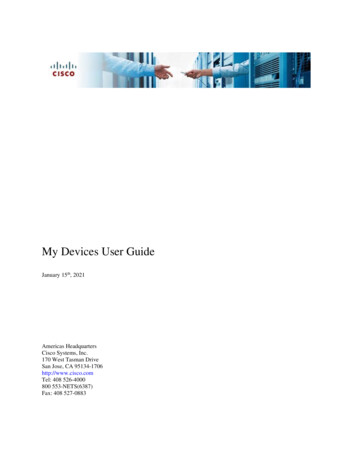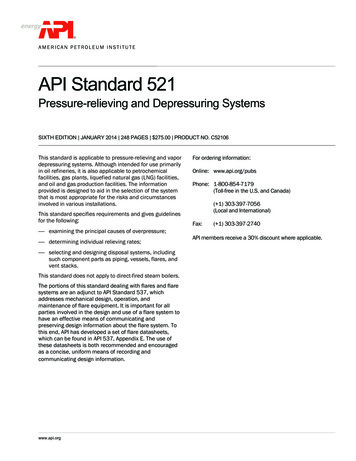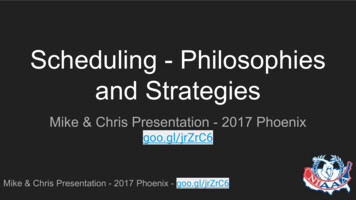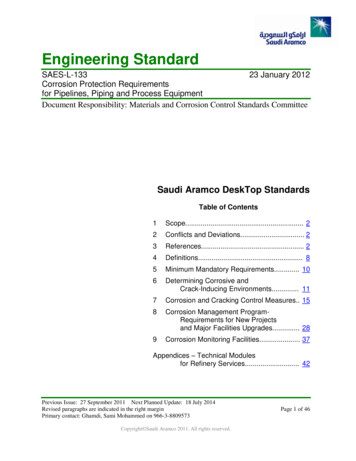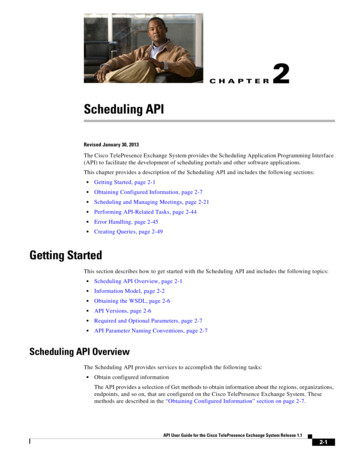
Transcription
C H A P T E R2Scheduling APIRevised January 30, 2013The Cisco TelePresence Exchange System provides the Scheduling Application Programming Interface(API) to facilitate the development of scheduling portals and other software applications.This chapter provides a description of the Scheduling API and includes the following sections: Getting Started, page 2-1 Obtaining Configured Information, page 2-7 Scheduling and Managing Meetings, page 2-21 Performing API-Related Tasks, page 2-44 Error Handling, page 2-45 Creating Queries, page 2-49Getting StartedThis section describes how to get started with the Scheduling API and includes the following topics: Scheduling API Overview, page 2-1 Information Model, page 2-2 Obtaining the WSDL, page 2-6 API Versions, page 2-6 Required and Optional Parameters, page 2-7 API Parameter Naming Conventions, page 2-7Scheduling API OverviewThe Scheduling API provides services to accomplish the following tasks: Obtain configured informationThe API provides a selection of Get methods to obtain information about the regions, organizations,endpoints, and so on, that are configured on the Cisco TelePresence Exchange System. Thesemethods are described in the “Obtaining Configured Information” section on page 2-7.API User Guide for the Cisco TelePresence Exchange System Release 1.12-1
Chapter 2Scheduling APIGetting Started Schedule and manage meetingsThe API provides methods to schedule new meetings, modify existing meetings, and cancelmeetings. For more details see the “Scheduling and Managing Meetings” section on page 2-21. Perform tasks that are related to the APIThe API provides services that are related to managing the Scheduling API. These methods aredescribed in the “Performing API-Related Tasks” section on page 2-44.Information ModelThe API uses a number of information elements. These elements are described in the following sections: Service Provider, page 2-2 Region, page 2-2 Resource Groups and Reservation Types, page 2-3 Organization, page 2-3 Endpoint Types, page 2-4 Endpoint Capacity, page 2-4 Custom Layouts, page 2-5 Meeting Types, page 2-5 Meeting Extensions, page 2-6 Inherited Values, page 2-6Service ProviderA service provider offers telepresence services to a set of business customers (organizations) by usingmedia resources that are provisioned in one or more regions in their network.The Cisco TelePresence Exchange System provides the ability to customize the service greetings andIVR prompts for each service provider.RegionA region represents a major geographic area in which a service provider operates.The region contains one or more resource clusters that generally include either a Cisco TelePresenceMultipoint Switch and/or Cisco TelePresence MSE 8000 Series, a Cisco router with integrated voiceresponse (IVR) records, and a Cisco Session Border Controller (SBC). A resource cluster is a connectedset of resources in one physical data center and is also known as a point of presence (POP).All media resources in a region are considered to be equivalent for resource allocation purposes, even ifthe resources span multiple POPs.A service provider can be associated with multiple regions that are configured on a Cisco TelePresenceExchange System, and it is possible for a given region to contain resources for different serviceproviders.API User Guide for the Cisco TelePresence Exchange System Release 1.12-2
Chapter 2Scheduling APIGetting StartedResource Groups and Reservation TypesResource groups and reservation types provide greater flexibility and control of how media bridgeresources are allocated for Meet-Me and Rendezvous meetings.When configuring a resource group, you choose a specific service provider and region and one or morereservation types to be associated with the group. After the resource group has been created, youassociate specific media bridge resources to the group. Based on the set of requirements configured fora meeting (such as service provider, region, reservation type, and endpoint requirements), the systemselects the best-fit resource group and associated media bridge resources to use for the meeting.The reservation type determines whether the system provides a guaranteed or best-effort level of servicewhen reserving a media bridge resource for a Meet-Me or Rendezvous meeting. The reservation typelevels of service are defined as follows: Guaranteed—When you create a guaranteed Meet-Me meeting, the system reserves media bridgeresources for the specified meeting duration. For a guaranteed Rendezvous meeting, the systemreserves resources for the meeting that can never be used for other meetings. Best-effort—When you create a best-effort Meet-Me or Rendezvous meeting, the system does notreserve any media bridge resources in advance for the meeting. Instead, the system allocatesresources when the first participant joins the meeting and deallocates resources when the lastparticipant leaves the meeting. For a best-effort meeting, the system may fail to allocate resourcesto the meeting because all the available resources may be in use by other best-effort meetings forthe given time period.You configure Meet-Me meetings, Rendezvous meetings, and resource groups to be associated withspecific reservation types. When creating a resource group, you configure the allowable amount ofdedicated media resources and meeting booking capacity for each reservation type chosen. Assigningboth a guaranteed and best-effort reservation type to a single resource group allows you to dedicate aspecific percentage of the resources to guaranteed meetings and another percentage to best-effortmeetings. For best-effort meetings, you have the capability to overbook the media bridge resources.Overbooking assumes that all Meet-Me and Rendezvous meetings associated with a specific reservationtype will not be active at the same time. By having different levels of overbookings, you can providedifferent service levels (for example, Gold, Silver, and Bronze) whereby the higher service levels havelower overbooking and thus have a higher likelihood of successful meetings.OrganizationAn organization is a business customer that is served by a service provider. An organization controls oneor more telepresence endpoints that can be included in a meeting. An organization can choose hostedendpoint service or enterprise endpoint service.With hosted endpoint service, the service provider operates the telepresence service on behalf of thebusiness customer. Endpoints are managed by a Cisco TelePresence Manager that is owned by theservice provider.With enterprise endpoint service, the enterprise organization operates their conferencing services and theservice provider provides inter-company connectivity. Enterprise endpoints are managed by aCisco TelePresence Manager that is owned by the organization. One-Button-to-Push (OBTP)functionality, which provides easy access to meetings, is not supported for enterprise endpoint service.Organization Ports ManagementOrganization ports management allows each organization to optionally control the amount oforganization bandwidth that is consumed by telepresence traffic on the network between the organizationand the Cisco TelePresence Exchange System.API User Guide for the Cisco TelePresence Exchange System Release 1.12-3
Chapter 2Scheduling APIGetting StartedYou specify the maximum number of ports when you configure an organization. The units are segments(screens). The ports required for each endpoint are specified in the endpoint table. If you wish to useorganization port management, you can specify the ports that are required by endpoints when youschedule a Meet-Me or remote meeting. (See the “Meeting Types” section on page 2-5 for a descriptionof the meeting types.)When the system schedules a Meet-Me or remote meeting, the port requirement for each organization iscalculated, based on the endpoints that are included in the meeting. If the total port capacity for theorganization (for all meetings that are scheduled in this time slot) exceeds the maximum value, thesystem rejects the attempt to schedule this meeting.Endpoint TypesThe Cisco TelePresence Exchange System supports SIP, TIP, and standards-based endpoints from CiscoSystems and third-party suppliers. The system provides full dial-in and dial-out capabilities for SIP andTIP endpoints. The system provides dial-out service to standards-based H.323 and ISDN endpoints.The Cisco TelePresence Exchange System supports the following types of endpoints: Provisioned endpoints—Endpoints for which all configuration details (such as name, phone number,number of screens, and organization) are known by the administrator and configured on theCisco TelePresence Exchange System. Meet-Me and direct dial calls are placed on provisionedendpoints. Unprovisioned endpoints—Endpoints for which none of the configuration details are known by theadministrator except the name of the meeting scheduler for the endpoint. Through the administrationconsole you can reserve bandwidth for unprovisioned endpoints on the service provider network.This allows the endpoint to connect with other known endpoints within the network that arescheduled for the same meeting. This capability is useful for intercompany meetings. Remote endpoints—Endpoints for which no configuration details are known. Remote endpoints areendpoints that join the meeting from another service provider network. Configuring a remoteendpoint on the Cisco TelePresence Exchange System reserves capacity for the endpoint on theservice provider network on which it is resident. The Cisco TelePresence Exchange Systemautomatically determines and reserves the capacity to support these interprovider meetings.NoteOrganization port management does not manage remote endpoints.Endpoint ProtocolsThe Cisco TelePresence Exchange System supports endpoints that use the following protocols: ISDN—Integrated Services Digital Network. H.323—ITU Specifications for Voice over IP networks and endpoints. SIP—Session Initiation Protocol. TIP—TelePresence Interoperability Protocol. MUX—A Cisco proprietary protocol, which was a predecessor of TIP.Endpoint CapacityThree factors determine how many segments the Cisco TelePresence Exchange System reserves for anendpoint:API User Guide for the Cisco TelePresence Exchange System Release 1.12-4
Chapter 2Scheduling APIGetting Started The bridge type that handles the call (Cisco TelePresence Multipoint Switch or Cisco TelePresenceMSE 8000 Series) The type of call (dial in or dial out) The number of endpoint screensFor more details on endpoint capacity calculation, see the Endpoint Capacity appendix of the Installationand Administration Guide for the Cisco TelePresence Exchange System exchange system/1 1/install admin/book/b installadmin.html.Custom LayoutsWhen you create or modify a meeting, you can optionally enter a value for the screen layout. This valuewill be used if the meeting is hosted on a Cisco TelePresence MCU MSE 8510, which supports a varietyof screen layout options.For details about the layout values, see the “Conference Layouts” section of the Cisco TelePresenceMCU API reference guide ucts programming reference guides list.html.When the conference is not hosted on a Cisco TelePresence MCU MSE 8510, the customLayoutparameter is ignored.Meeting TypesThe Cisco TelePresence Exchange System supports the following types of meetings: Meet-Me meeting—A scheduled meeting that is hosted by this Cisco TelePresenceExchange System. The Cisco TelePresence Exchange System reserves media resources based on theparameters that you configure for the meeting. Typically, a Meet-Me meeting is associated with aguaranteed reservation type. You can configure a Meet-Me meeting to provide One-Button-to-Pushfunctionality for the provisioned endpoints and to reserve organization bandwidth. You can alsodesignate the host participant role to one or more endpoints to control access to a Meet-Me meeting. Remote meeting—A scheduled meeting that is hosted by a remote Cisco TelePresenceExchange System. The Cisco TelePresence Exchange System does not reserve any media resourcesfor a remote meeting. You schedule remote meetings to provide OBTP functionality in theprovisioned endpoints and to reserve the bandwidth, if requested. Scheduled two-party direct meeting—A scheduled direct dialed meeting between two hostedprovisioned endpoints. The Cisco TelePresence Exchange System does not reserve any mediaresources for a direct dialed meeting. Two-party direct meetings are scheduled to provide OBTPfunctionality for those endpoints within the same organization. Rendezvous meeting—A predefined meeting that can occur at any time (not scheduled for a specificstart time). A Rendezvous meeting instance starts when any participant dials into the meeting.Typically, a Rendezvous meeting is scheduled with a best-effort reservation type. With a best-effortreservation type, the Cisco TelePresence Exchange System does not reserve any media resources fora Rendezvous meeting. OBTP is not applicable for Rendezvous meetings. A Rendezvous meetingmay optionally assign the host role to one or more endpoints, to control access to the meeting. If ahost is assigned, the meeting starts only when the host (or alternate host) dials into the meeting.API User Guide for the Cisco TelePresence Exchange System Release 1.12-5
Chapter 2Scheduling APIGetting StartedMeeting ExtensionsYou can optionally configure a meeting to extend its duration automatically. The meeting will only beextended if there are any active participants at the time that the system checks for available resources forthe extension, which happens shortly before the two minute end-of-meeting warning.You can allow one or more extensions of the meeting. You can also specify the length of the meetingextension (in minutes). This value must be a multiple of 15 (i.e. extensions are allowed in 15-minuteincrements).The maximum number of extensions times the extension length must not exceed 24 hours.Inherited ValuesThe MeetingExtension element and the DropParticipantOnHostExit element are examples ofenumerated types which allow a value of INHERIT.If you set the value in the meeting to INHERIT, the meeting inherits the behavior defined by theorganization hosting the meeting. In the organization element, INHERIT indicates that the organizationwill inherit the behavior from the service provider. A value of INHERIT is not valid in the serviceprovider element.If you set a value other than INHERIT for a meeting, the value in the meeting will override the value setfor the organization. Similarly, setting a value other than INHERIT for the organization will override thevalue set for the service provider.Obtaining the WSDLYou can access the WSDL file for the Scheduling API athttp:// DNS name or IP address for your admin server :8080/ctxapi/api/v1 1/sched?wsdlThe WSDL file provides a complete and accurate definition of the API that is supported by yourCisco TelePresence Exchange System. In the event of any discrepancies between the WSDL file and thisdocument, you should follow the WSDL file definition.API VersionsAt time of publication, the latest version of the Scheduling API is version 1.1, which is accessed by usingthe WSDL URL listed above.Cisco TelePresence Exchange System also supports version 1.0 of the Scheduling API, which you canaccess by using the following URL:http:// DNS name or IP address for your admin server :8080/ctxapi/api/sched?wsdlFor notes on backward compatibility with Cisco TelePresence Exchange System Release 1.0, seeAppendix A, “Backward Compatibility.”NoteThis document describes version 1.1 of the API. The documentation for version 1.0 of the API isavailable from Cisco.com at the following x/exchange system/1 0/api guide/api guide 101.htmlAPI User Guide for the Cisco TelePresence Exchange System Release 1.12-6
Chapter 2Scheduling APIObtaining Configured InformationRequired and Optional ParametersIn the parameter tables throughout this chapter, we identify optional parameters by starting thedescription field with the following notation: (Optional). All other parameters are required.API Parameter Naming ConventionsThe API uses the following conventions for parameter names.KeyThe Scheduling API assigns a unique string identifier (called a key) to entities in the object model, suchas service provider, organization, endpoint and meeting.You use the key in subsequent API requests to ensure that the service selects the correct item.NameIn addition to the unique key, the API returns the name string for the entity if the entity was provisionedwith a name. The name provides a human-readable identifier for the item (for use in a UI display or areport).DescriptionLike the name, the API returns a description string for the entity if the entity was provisioned with adescription. The description provides a human-readable description for the item (for use in a UI displayor a report).Obtaining Configured InformationThe Scheduling API provides “Get” methods for retrieving configured information about endpoints,regions, organizations, and so on, that are configured on the Cisco TelePresence Exchange System. Themethods are described in the following sections: getEndpointAvailability, page 2-8 getEndpoints, page 2-9 getEndpointsForOrganization, page 2-10 getMediaProfiles, page 2-10 getOrganizations, page 2-11 getOrganizationsForServiceProvider, page 2-14 getPortsByOrganization, page 2-14 getRegions, page 2-15 getRegionsForServiceProvider, page 2-16 getReservationTypes, page 2-16 getServiceNumbers, page 2-17API User Guide for the Cisco TelePresence Exchange System Release 1.12-7
Chapter 2Scheduling APIObtaining Configured Information getServiceProviders, page 2-18 getWhiteListGroups, page 2-20getEndpointAvailabilityThe Get Endpoint Availability service returns the availability status for a list of endpoints that meet thecriteria that are supplied in the request.Table 2-1 describes the parameters in the service request.Table 2-1Get Endpoint Availability nter the key for one or more endpoints.dateTimeStrDate/Time,ISO 8601Enter the starting date and time of the duration for which endpointavailability will be reported.durationintEnter the length (in minutes) of the duration for which endpointavailability will be reported.searchGranularityintEnter the granularity (in minutes) of the period for eachavailability status. For example, a value of 15 means that theendpoint availability will be reported for each 15-minute period inthe duration.The service returns a Get Endpoint Availability Result in the service response. Table 2-2 describes theGet Endpoints Result.Table 2-2Get Endpoint Availability ComplexList of endpointAvailability elements. See Table 2-3 for adescription of endpointAvailability element.Table 2-3 describes the endpointAvailability element.Table 2-3endpointAvailability ique identifier for the endpoint.freeBusyenumerationAvailability is an enumeration, which allows the string values of“FREE” or “BUSY”.The endpointAvailability element will include multiple values offreeBusy (one for each period in the duration that was specifiedin the request). For example, if duration is 60 andsearchGranularity is 15, there will be four values of freeBusy(one for each 15-minute period).API User Guide for the Cisco TelePresence Exchange System Release 1.12-8
Chapter 2Scheduling APIObtaining Configured InformationgetEndpointsThe Get Endpoints service returns a list of endpoints that meet the criteria that are supplied in therequest.Table 2-4 describes the parameters in the service request.For additional information about the parameters that control pagination (startingIndex
schedule a Meet-Me or remote meeting. (See the “Meeting Types” section on page 2-5 for a description of the meeting types.) When the system schedules a Meet-Me or remote meet ing, the port requirement for each organization is calculated, based on the endpoints that are in





